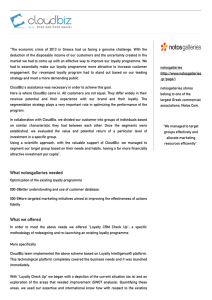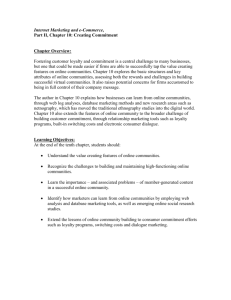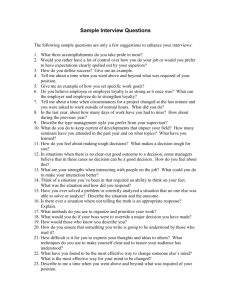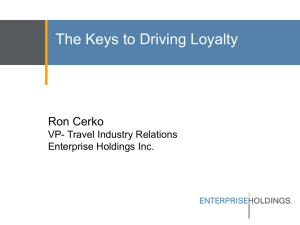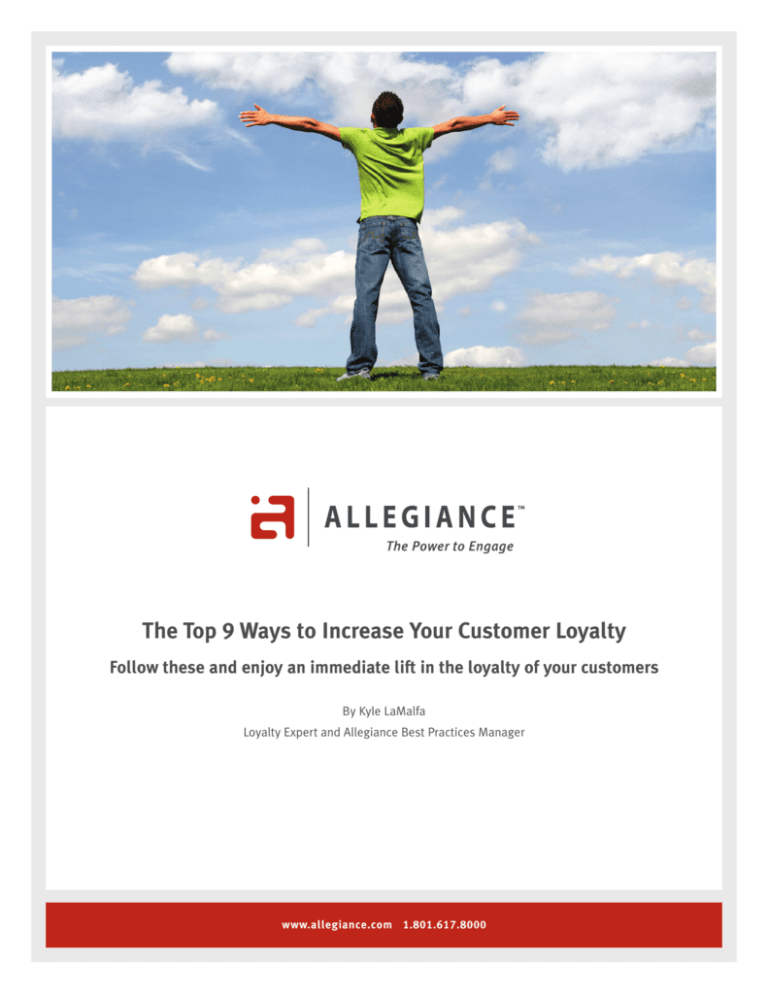
The Top 9 Ways to Increase Your Customer Loyalty
Follow these and enjoy an immediate lift in the loyalty of your customers
By Kyle LaMalfa
Loyalty Expert and Allegiance Best Practices Manager
www.allegiance.com 1.801.617.8000
The Top 9 Ways to Increase Your Customer Loyalty
What is the Key to Business Success?
Every company executive will raise their hand and say they believe having loyal customers
is a key to business success. But what are executives really doing about it? Most will point
to their customer care training or CRM system and say, “that’s how we take care of loyalty
here.” Some will also point to their monthly newsletter or discount program to demonstrate their efforts. All of these are good attempts. However, they are not enough.
Fostering true loyalty and engagement with customers starts at a basic level. These 9
principles will guide you in your efforts to create greater loyalty and engagement within
your organization. It’s one of the most critical ways to retain more of your customers and
grow your business faster. It can also be a powerful competitive edge. To understand why
this is so necessary, let’s review the common problem facing most businesses today:
Companies are losing customers at a staggering rate, without really hearing
from most of them …
• Each year the average company loses 10-15% of its customer base
– Bain & Company
• “84% of customers who leave, do so because of poor service”
– Forum Corp
• “A typical business only hears from 4% of its dissatisfied customers—the other 96%
leave, 91% for good”
– Jim Barnes, “Secrets of CRM”
By understanding these basic 9 principles, and putting them into practice at your
organization, you’ll foster a culture of greater loyalty and engagement that will reward
you with greater profits.
If you can’t tackle all of these right away, start with just one, then move on to another one
after that, etc. The most important thing is that you start as soon as possible. As you better practice these, and track results, you will see loyalty levels swiftly increase.
I’ve broken these into 3 primary groups:
• Basic Concepts
• Technologies
• Business Outcomes
www.allegiance.com 1.801.617.8000
60% and 80% of defecting
customers describe themselves
as “satisfied” or “very satisfied”
just before they leave.
Business Week, October 2006
It costs between 5 and 10x more
to attract a new customer than to
keep an existing one.
The Council on Financial Competition
70% of the reason customers leave
a company has nothing to do with
the product.
Forum Corporation
The Top 9 Ways to Increase Your Customer Loyalty
Basic Concepts
Understand 3 fundamental concepts about customer loyalty in order to make sure you
are building on a solid foundation.
1. Satisfy your customers with product quality.
Satisfaction is the difference between your customer expectations and your service
delivery. Know your customer’s expectations and be prepared to evolve your product.
This is basic business 101, but often it is ignored. People try all sorts of loyalty and
sales gimmicks, yet ignore the fundamental business concept that business needs to be
a balanced transaction: someone pays for something and expects a fair trade in return.
Expectations of product quality come from many sources including, previous quality
levels set by your organization, value propositions set in the competitive landscape,
and impressions in the media.
“Executives are finding that the
winning differentiator is no longer
product or price, but the level of
customer engagement relative to
the competition.”
– Rama Ramaswami, Senior Editor,
Economist Intelligence Unit
2. Build loyalty by exceeding expectations and building opportunities for
repeat business.
A generation ago, customer loyalty was a different game. Today’s customers are quick
to switch to the competition. Remember, your competitors are only a mouse click away.
a. Be acutely responsive to customer questions, comments & complaints (yeah,
that’s right, complaints.) Often, these are your MOST loyal customers. If you
resolve a complaint quickly, you can actually GROW loyalty
b. Drive product development to offer more value for less cost
c. Give your customers a chance to be loyal by offering products for repeat business
3. Engage your customers by reaching out to create a dialog.
Engagement strengthens your company’s relationship with your customer by providing
an open channel for communication and feedback. An engaged customer is more than
satisfied and more than loyal. They go out of their way to show their association with
your company. They also support you during both good and bad times because they
believe what you have to offer is superior to others.
Engagement takes your customer beyond passive loyalty to become an active participant and promoter of your product. And engaged customers will want to give you more
feedback – and you should be ready to handle it! All this translates into a more engaged
customer who will spend more money with you over time.
So how do you become a company that actively engages its customers?
Follow these simple rules:
a. Listen to customer feedback from comment cards, letters, phone calls, and surveys
b. Respond quickly and personally to concerns of high interest to your customers –
if you respond quickly, you can actually increase loyalty
c. Organize unstructured feedback for tracking and trending over time
d. Trust your customers to tell you what the problem is
e. Use statistical techniques to discover which action items will have the most impact
on your business outcomes
www.allegiance.com 1.801.617.8000
The Top 9 Ways to Increase Your Customer Loyalty
Technologies
Adopt technology to help you manage large volumes of unstructured data and create
actionable information from your feedback.
1. Complaint Management
Managing questions, comments, and concerns benefits your business in two
important ways. First, as mentioned earlier, research indicates that an upset customer
whose problem is addressed with swiftness and certainty can be turned into a highly
loyal customer. Second, unstructured feedback, gathered and managed appropriately,
can be a rich source of ideas. Hidden gems exist in your customer’s complaints.
You can start to collect and use that information as you:
a. Establish channels (electronic, phone, written) to build engagement one
customer at a time
b. Encourage customers to let their voice be heard
c. Create metrics to improve response to concerns (“time to first response,”
“time to resolution”)
d. Create metrics to measure loyalty before and after the problem
e. Use technology to help you centralize the information, create reports,
and structure drill-downs
2. Pro-active Surveys
Actively soliciting information from a population of customers is a time-tested technique
pioneered by Arthur Nielsen (creator of the Nielsen ratings) in the 1920s. Survey
research can be used for problem identification or problem solving. Questions with
simple scales such as “agree/disagree” or “satisfied/unsatisfied” deliver quantitative
insight for problem identification. Open-ended follow-up questions provide rich insight
for problem solving. You can use a professional when survey help is needed.
a. Make sure your surveys are short, bias-free and well structured
b. Use random sampling to gather feedback continuously without over-surveying
c. Create summary survey indices that can be displayed graphically and
tracked over time
3. Enterprise Feedback Management
Enterprise Feedback Management (EFM) is more than just collecting data. EFM adopts
a strategic approach to building dialogs with your customers. By wrapping customer
dialogs with a technology, your company creates a structured, searchable and
quantifiable body of information that can be used to drive critical business decisions.
a. Empower customers to give feedback through common
advertised channels
b. Centralize reporting for pro-active surveys and complaint management solutions
c. Structure quantitative feedback into a drill-down or rollup report
d. Make open-ended feedback intuitively searchable
www.allegiance.com 1.801.617.8000
“The term Enterprise Feedback
Management (EFM) is a term that
started being used in 2004. Today,
there are many companies that claim
to be EFM, but most have only one or
two components, and therefore are
limited to just tactical feedback.
For true EFM you need the ability to
gather feedback, both solicited
(such as through surveys and mystery
shopping) and unsolicited (comment
cards, web or other electronic
submissions and in-person/live
submissions).
Then, you also need the ability to
manage that feedback, generate
enterprise-wide reports, use analytics
and dashboards, and make sense of it
all with professional services. If a
simple survey company claims they
are Enterprise Feedback Management,
turn and walk away, quickly.”
– John Epeneter, VP Product
Management, Allegiance, Inc.
The Top 9 Ways to Increase Your Customer Loyalty
Business Outcomes
Tie the latest ‘soft measures’ such as satisfaction, loyalty, and engagement to
‘hard measures’ of actual business outcomes
1. Descriptive Statistics
Answers to survey questions take the form of either categorical (What state do you live
in?), order-scaled (To what extent do you agree with…), continuous-scaled (What year
were you born?) or open-ended (What do you like about…). Descriptive statistics such
as mean, median, mode, top-box, and frequency cross-tabs summarize the multitude of
responses into manageable information. Descriptive statistics may lie to you by failing
to uncover relationships within your data, so be careful!
a. Don’t assume that the average is an appropriate measurement for every situation
b. Make sure your analyst understands the nuanced interpretation of the
right statistic
c. Use crosstabs to begin to understand relationships between two variables
d. Generously use graphics to convey information to non-technical people
2. Predictive Analytics
Businesses use a variety of statistical techniques to make predictions about the
potential for future events. Furthermore, predictive analytics may be used to ascertain
the degree to which answers from a survey relate to particular goals (such as loyalty
and engagement). Tactical knowledge of action items that impact an outcome
discourages the wasting of resources on ineffective programs, and competent statistical
modeling reveals the insight of which tactical options have the most impact.
a. Analyze data using a statistical technique to reveal the most important
areas of focus
b. Ask your analyst about common statistical methods including correlation,
multiple regression, factor analysis, and logit models
c. Recognize that the important areas of focus may change over time to respond
with changes in the economic, competitive, and demographic environment of
your business
3. Alignment with Business Outcomes
Whatever you do, the ultimate goal should be oriented to optimize business outcomes
specific to your circumstances. Orienting your organization to focus on satisfaction,
loyalty and engagement is no panacea. However, researchers have clearly documented
evidence of short-term benefits to customer/employee retention and long-term
benefits to profitability. In the modern economic landscape, loyal customers and
loyal employees supply your organization with a huge competitive advantage.
a. Determine whether your engagement outcome is best measured by satisfaction,
likelihood to purchase again, likelihood to recommend, or another voice of the
customer (VOC) metric
b. Create hybrid VOC measurements using more than one metric if necessary
www.allegiance.com 1.801.617.8000
“One of the biggest business
growth opportunities today is to
focus on engagement. Companies
that make it fundamental to their
business cannot be touched by
competitors. They enjoy more profits during tough times, and grow
faster during good times. It truly is
an untapped opportunity just waiting for those who will grab it.”
– Adam Edmunds, CEO,
Allegiance, Inc.
The Top 9 Ways to Increase Your Customer Loyalty
c. Link your VOC metrics with business outcomes like shareholder returns, annual
sales growth, gross margin, market share, cash flows, Tobin’s Q, customer churn,
or employee turnover
d. Be aware that changes in loyalty/engagement scores generally precede changes in
business outcomes (typically by 45-60 days)
It may not be the easiest process to do by yourself, but stay focused and keep your eye
on the goal: increasing your engagement and loyalty equals increasing profits and a
strong competitive edge. Don’t feel like you need to do everything yourself. If you want
to make it happen. Choose a partner who has the technology, best practices and
experience already in place and ready to help you. Allegiance is that partner.
Allegiance
For more information about how to increase your loyalty and engagement, visit
www.allegiance.com and learn about the Allegiance Engage Platform, which is a
software platform and services designed to help companies actively build
engagement and link it to business outcomes to grow revenue faster.
About the Author
Kyle LaMalfa
Allegiance Best Practices Manager & Loyalty Expert
kyle.lamalfa@allegiance.com
Kyle LaMalfa helps Allegiance clients fine tune and optimize their customer, employee,
and feedback engagement processes to align closely with idealized standards.
LaMalfa has been analyzing data professionally since 1996. Along with undergraduate
degrees in mathematics and economics, LaMalfa will complete a master's degree in
statistics in 2007. His professional experience includes time as a software quality
engineer for a large financial services company, a data warehouse engineer at a
mountain resort, a freelance consultant for local businesses, and the lead statistician
for a market research company. Throughout his career, LaMalfa has worked with managers and executives to answer business questions using statistical data and research.
Problem solving specialties include customer/employee attrition, customer/employee
engagement, data mining and predictive modeling.
©2007 Allegiance, Inc. All rights reserved.
www.allegiance.com 1.801.617.8000





